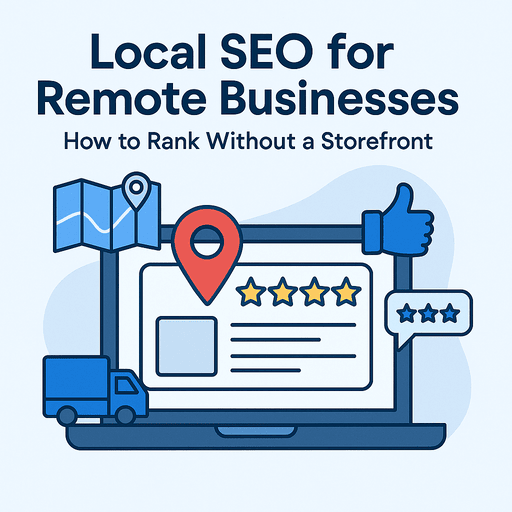Local SEO for Remote Businesses: How to Rank Without a Storefront

Short Answer: Remote and service-based businesses can absolutely win in local search, even without a brick-and-mortar location. The secret is mastering your Google Business Profile as a service area business, creating location-specific pages that feel authentic, and building a reputation through reviews and local signals. Done right, you can outrank storefront competitors while never hanging a sign above a door.
Introduction
Local SEO used to feel like a closed club. Coffee shops, law offices, salons, or anyone with a physical address had the upper hand. But what about the thousands of businesses that never see customers in a storefront? The HVAC pro who works out of a van. The marketing consultant who runs everything from a laptop. The cleaning company that drives across town but never invites clients to an office.
For years, these service-based and remote businesses assumed they were invisible in local search. Today, that’s no longer true. Google has cracked the door wide open for service area businesses, and the ones who seize the opportunity are dominating results in their cities.
This guide shows you exactly how to pull it off.
What Is Local SEO for Remote Businesses?
At its core, local SEO for remote businesses is about visibility without a public address. Google calls these setups “service area businesses.” Instead of displaying a street address, you define your coverage by cities, postal codes, or counties.
The difference is subtle but huge. Storefront businesses rely on proximity to rank. Service area businesses rely more heavily on trust, relevance, and authority signals. For industries like home services, coaching, or consulting, the model fits perfectly.
Think of it this way: your competitors’ storefront is their address. Yours is your profile, your pages, and your reputation.
Key Strategies for Local SEO Without a Storefront
1. Transform Your Google Business Profile Into a Service Area Powerhouse
- Remove your street address if clients don’t visit you. Define your service areas honestly.
- Choose categories that match what you actually do. Google uses this as a primary ranking factor.
- Upload photos and videos. Even without a storefront, you can show trucks, before-and-after projects, or your team at work.
- Post updates. SABs often forget that GBP posts are free mini-ads sitting right in search results.
- Push for reviews, and encourage clients to mention their neighborhood or city by name.
2. Build Localized Landing Pages That Actually Add Value
If your service area covers five towns, your site should reflect it. Create a dedicated landing page for each major city or region, but don’t churn out lazy copy-paste jobs.
Instead, make each page feel like it belongs to that area:
- Reference local landmarks, neighborhoods, or common challenges.
- Add testimonials from customers in that city.
- Highlight case studies or seasonal issues unique to the region.
3. Own Your Local Citations
- Submit your info to industry directories, chambers of commerce, and community portals.
- Ensure NAP (name, address, phone) consistency everywhere.
- Audit your listings regularly to fix duplicates or inconsistencies.
4. Use Schema to Speak Google’s Language
- Add LocalBusiness or Service schema with serviceArea properties.
- Use review markup if you showcase testimonials.
- Apply breadcrumb schema for multi-location navigation.
5. Make Reviews Your Superpower
- Ask every happy customer for a review, ideally with city mentions.
- Reply to reviews quickly, even the negative ones.
- Feature reviews on your service-area pages.
6. Get Creative With Geo-Targeted Content and Links
- Partner with local nonprofits or events for sponsorship backlinks.
- Write blog posts about seasonal or regional challenges.
- Embed maps and images that ground your business in a location.
FAQs
Can I show up in Google Maps without a physical location?
Yes. You’ll appear as a service area business. Customers won’t see a pin on your house, but you can still appear in the local pack.
Should I set up multiple Google Business Profiles?
No. Stick to one and use the service area feature.
What about using a coworking or virtual office address?
Risky. Unless you actually staff that location during business hours, Google may suspend you.
How big should my service area be?
Keep it realistic. Google recommends areas within about two hours of travel time.
Is it harder to rank without a storefront?
It can be, since storefronts get a proximity boost. But with stronger content, reviews, and local signals, remote businesses can still dominate.
Conclusion: Local SEO Without a Storefront Is About Trust
Local SEO is no longer reserved for businesses with street numbers and signage. Remote companies, service providers, and consultants can absolutely win — but the game is different.
Your weapons are not four walls and a roof. They are your profile, your content, your reviews, and your local footprint. Nail those, and you can rank right alongside or even above storefront competitors.
If you are a remote or service-based business ready to take control of your local search presence, contact me today for expert SEO guidance tailored to your service areas.

0 Comments Add a Comment?